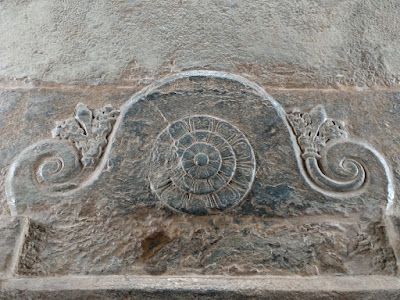June 15, 2022
The agenda of the day was to see monuments at Dambal, Lakkundi, Gadag and Annigeri. I reached Dambal around 7-15 am. Dambal tour Doddabasappa Devastana & Someshwara Devastana, the stepped well called Japada Bavi ruins of Dambal fort & Victoria lake, and two small historic temples. The drive from Dambal to Lakkundi was about 40 minutes. I approached Lakkundi from its southern border close to which are Halugonda Basaveshwara Gudi, Kashivishveshwara Devastana and Nanneshwara Devastana. Basaveshwara Gudi was a venue for some event, it was crowded, so I skipped it, spent about an hour at Kashivishveshwara and Nanneshwara - amazing details in sculptures of both temples. The next place I stopped at was the archaeological museum, adjacent to the museum is Brahma Jinalaya. Built in the XI Century CE, Brahma Jinalaya is said to be the oldest Jaina temple in this region. Also, it is the biggest Jaina temple here. As you see the temple is a grand looking structure.
This is the rear-side view. The structure's base is sloped, giving it a kind of pyramidal look. Also it appears like a two-storey structure because of the multi-tiered Shikhara. Adjacent to the main temple is the smaller structure which is the secondary Jaina shrine.
These temples were built in 1007 CE by Danachintamani Attimabbe, wife of the local general named Dandanayaka Nagadeva. Several inscriptions were found at this temple stating the details of the gift received before the XIV Century CE. In the inscriptions, this temple has been called as "Brahma Jinalaya of Lokkigundi."
The raw material used in earlier Chalukyan temples was sandstone. During the Kalyani Chalukyan time, builders had moved to soapstone. All historic temples of Lakkundi are built of soapstone which is more workable and longlasting.
The primary and secondary structures have a small gap between them, just wide enough for a man to pass through. The primary (main) temple exterior is more ornate compared to the secondary.
This is the rear-side view of the secondary structure.
The front-side view.
It is said that during or after the war of XIII Century CE these temples were damaged. British explorer Henry Cousens & his team of archaeologist found them in dilapidated condition. ASI has restored them to the present condition. This headless idol of Neminataha is said to be the deity of Brahma Jinalaya.
Lets check out the interior of the main temple. This is the Navaranga Mantapa. The two polished pillars seen here is part of the four-pillared Natya Mantapa. Beyond the Natya Mantapa is the Antharala (vestibule), the Garbhagudi doorframe and Garbhagudi. Inside the sanctum is an idol of Neminatha.
In the Ranga Mantapa are two ancient idols. On the left is an idol of Saraswati and on the right is Chaturmukha Brahma.
At the entrance of Ranga Mantapa on the floor is this mural of lotus flanked by a pair of flower bunches.
This is the Mukhamantapa with Sukhanasi. This open pillared hall can also be called as Sabhamantapa (meeting hall). The 32 pillars of this hall can be grouped into 5 or 6 types based on the form & design.
In this diagonal view we can see four types of pillar designs. three have cubical bases and one is ribbed/grooved from top to bottom.
This pillar design is simple amazing. Pillars are paired and positioned symmetrically.
Of all the pillar types, this design is probably the most complex.
This is the border of the open hall and the enclosed hall. One of the corner pillars is half done, may be the sculptors left this incomplete intentionally. Going by the looks of the workmanship, it looks like the pillared hall was an addition.
This image of a miniature assembly of Shikhara supported by beams and pillars has a special quality in it. See closely the sculptures between the Shikhara base and pillar tops, the vertical and horizontal steps are so precise... its a congregation of parallel lines. The more you look at it, it gets more attractive.
Brahma Jinalaya is one of the must see items in Lakundi. Indeed it is!
Lastly, this standalone structure sits at the north-eastern corner of the site. It looks like a temple's Mukhamantapa in the enclosing wall, of course the walls are missing.
A diagonal view of the gateway.
One last look at the marvelous Brahma Jinalaya before I leave this place. It would be a good idea for tourists to start their tour of Lakkundi from here. The museum has a list of surviving temples that could be visited.
It is said that Lakkundi was a place of 101 temples & 101 wells. However, the surviving number is less than 20. Of all the temples I've seen only three have stepped wells. This well below is opposite the museum building. The other two wells are at Manikyeshwara Devastana and Veerabhadreshwara Gudi.
.........
































1 comment:
Jay jinendra its very beutiful place marvellous architectural huge space and dates back 11th century badami pattadakle aihole same classic temple near gadg lovely keep going
Post a Comment